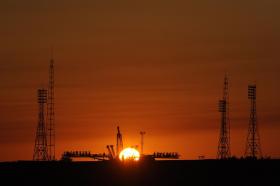On July 8 at 19:56 MLT a spacecraft “Meteor-M” N2 and six small spacecrafts including MKA-FKI N2 “RELEC” were launched from Baykonur launching site to the orbit by launch vehicle “Soyuz-2.1B” with “Fregat” booster.
Onboard the satellites “Meteor-M” N2 and MKA-FKI N2 “RELEC” there are scientific instruments developed by SINP scientists in cooperation with Russian and foreign partners in order to study radiation processes in the near-Earth space and the Earth's atmosphere.
The scientists plan both fundamental and applied research. High-energy charged particles fluxes generated by solar flares or during magnetic storms may cause damages or breakdown of radioelectronic equipment onboard spacecrafts. They are also dangerous for cosmonauts health, and sometimes even for the pilots and passengers of the airliners during the trans-polar airflights. Besides, high-energy charged particles fluxes can produce short-wave communication breakdown in the high-latitude regions, along with failures of navigation systems, decreasing of the accuracy of global navigation and position control.
The spacecraft “Meteor-M” N2 carries onboard a multichannel spectrometer developed by SINP scientists for global monitoring of the radiation state dynamics in the near-Earth space. Similar spectrometer is operated onboard the spacecraft “Meteor-M” N1, launched from Baykonur launching site on September 17, 2009 to the Sun-synchronous orbit with mean altitude of 830 km.
The spacecraft “Meteor-M” N2 is the second spacecraft within the space complex of hydrometeorological and oceanographical control “Meteor-3M”. Its total mass is 2778 kg, the payload mass is about 1250 kg, the active lifetime is 5 years.
The spacecraft MKA-FKI N2 manufactured on base of the “Karat” unified framework in the Lavochkin Scientific and Production Association carries onboard scientific instrument “RELEC” (Relativistic ELECtrons) developed by SINP scientists in order to study high-altitude electric discharges, atmospheric transient phenomena (sprites, blue jets, elves), precipitations of the relativistic electrons from the radiation belts of the Earth.
The «RELEC» is the second scientific instrument developed within the framework of the program MKA-FKI (Russian abbreviation for “Small spacecrafts for the fundamental space research”). Its total mass is about 100 kg, the payload mass is about 40 kg.
The “RELEC” scientific instrument is a complex of scientific equipment, including an X-ray and gamma-spectrometers, a three-dimensional electrons detector, a detector of UV and optical bursts, an instrument for high time-resolution optical imaging, low- and radio-frequency analyzers of electromagnetic field and radiowaves.
Basing on the scientific data obtained by the “Meteor-M” N2 spectrometer and the “RELEC” scientific instrument the scientists of the SINP Space Monitoring Center will solve the application problem of online monitoring and forecasting of the radiation state of the near-Earth space. In April 2014 a computer hall for data visualization with displaying of current space radiation state was opened in the Center.
Currently the Space Monitoring Center of SINP MSU receives information both from Russian (“Meteor-M” N1 and “Elektro-L” N1) and foreign spacecrafts (SDO - Solar Dynamics Observatory (NASA), ACE - Advanced Composition Explorer (NASA), GOES - Geostationary Operational Environmental Satellite (NOAA)).

